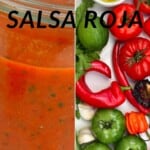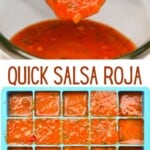This post may contain affiliate links. Please read our disclosure policy.
How to make salsa Roja (aka Roja sauce) at home with 10 ingredients, roasted and blended to perfection. This salsa Roja recipe is gluten-free and vegan, has tons of flavor depth, and is super versatile!

Having just shared a method for homemade corn tortillas, I have tons of Mexican-inspired recipes swirling around my head. What do they all need? The ultimate Mexican condiment: salsa Roja (aka roja sauce = ‘red sauce’)!
Recently, I’ve thrown myself head-first into all sorts of tomato recipes: refreshing gazpacho soup or warm comforting creamy tomato soup, roasted tomato pasta sauce, tomato burrata Caprese salad, or even tomato confit (just to name a few!). I also recently shared methods for Pico de Gallo and a mango salsa – this time it’s the turn of this salsa Roja recipe.
Want to save this recipe?
What is salsa roja?
There are two primary varieties of salsa in Mexico: salsa Roja (with red tomatoes) and salsa Verde (with tomatillo).
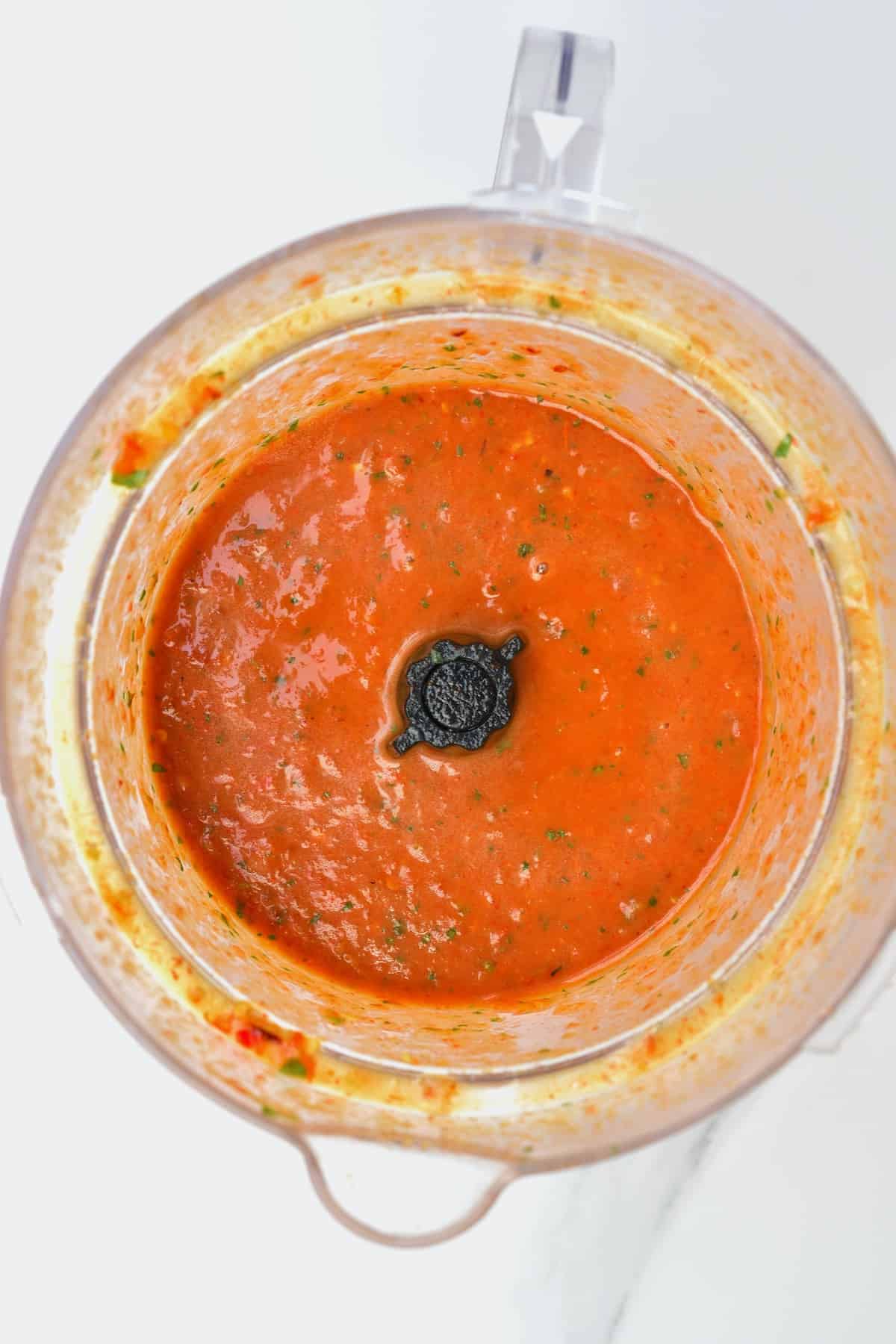
Salsa roja (aka ‘red sauce’) is a type of Mexican spicy red sauce made up of roasted then ground tomato, onion, garlic, and chili (with salt and pepper, of course). However, several variations of this include ‘salsa cruda’, which is made with the raw ingredients, and ‘salsa asada’ prepared with roasted ingredients (traditionally done over a Comal- a type of cast-iron griddle used for tortillas and arepas)
There are also methods that begin by blending the raw ingredients before reducing them down on the stovetop.
This salsa Roja recipe leans towards salsa Asada as I like to roast the vegetables first to charr the skins and develop their flavors before blending. I find this produces my favorite flavor of all the options.

This is one of those recipes passed down in families so that there isn’t really ONE specific authentic Mexican salsa Roja recipe. Instead, there are millions of minute variations: adapt the quantities of the ingredients, the spice level, seasoning, etc.
Once prepared, this Mexican red table sauce is the ultimate condiment to all your favorite Mexican dishes! Check my how to serve section for lots of options!
The ingredients
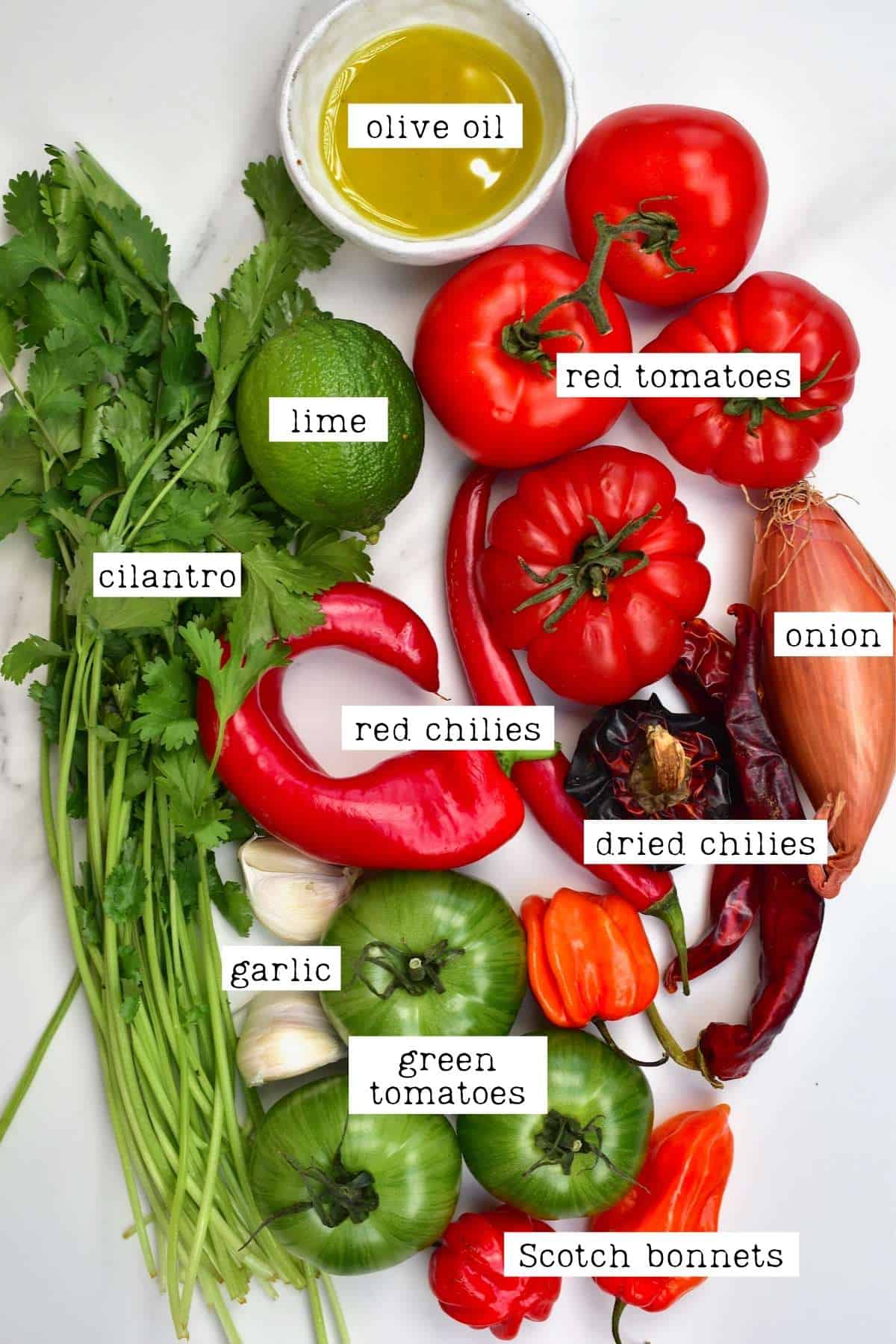
- Tomatoes: I used a combination of ripe, juicy red tomatoes (Roma tomatoes and Beef Steak tomatoes work best but use what is available to you) and green tomatoes. The green tomatoes aren’t necessary, but I like the depth of flavor – you could exchange them with tomatillo.
- Aromatics: I used a combination of onion and garlic. Feel free to adjust the amount of garlic to personal preference.
- Chiles: I like to use a combination of fresh and dry red chiles to add tremendous depth to the Roja sauce- For an authentic Mexican salsa, you can use Jalapeno (medium heat and similar to the medium red chilies I used), serrano (slightly hotter), or Arbol chilies (even hotter). For dried chilies, Guajillo is an excellent medium heat option or dried ancho (mild). I also added some very hot West African scotch bonnet peppers to this version as I had them in my pantry, but they’re 100% optional. Read the notes for more on this!
- Lime: Use fresh lime juice always!
- Cilantro: Use fresh cilantro for the best flavor and feel free to adjust this amount to your liking.
- Salt (Optional): Technically, this is optional, but I like to add a little salt to enhance the flavor.
- Vegetable stock: I use homemade vegetable stock to rehydrate the dried chilies. Alternatively, use salted water or water with a bit of stock powder.
- Oil: Cooking oil for when we roast the vegetables.
Optional: a dash of cumin is often added to Tex-Mex style versions of this Roja sauce.
How to make salsa roja
Step 1: Rehydrate the dried chilies
First, rehydrate the dried chili peppers. Cut off the stems and remove the seeds from the peppers. Then add them to a bowl of hot vegetable stock (for better flavor) or lightly salted boiling water. Simply toss them into the liquid and allow them to steep for 20-30 minutes.
Alternatively, for more depth of flavor, first, dry roast the peppers in a skillet for just 40-60 seconds per side, then rehydrate them for 15-30 minutes (based on the pepper thickness).
Save the liquid as you can use a little to help blend the salsa Roja.
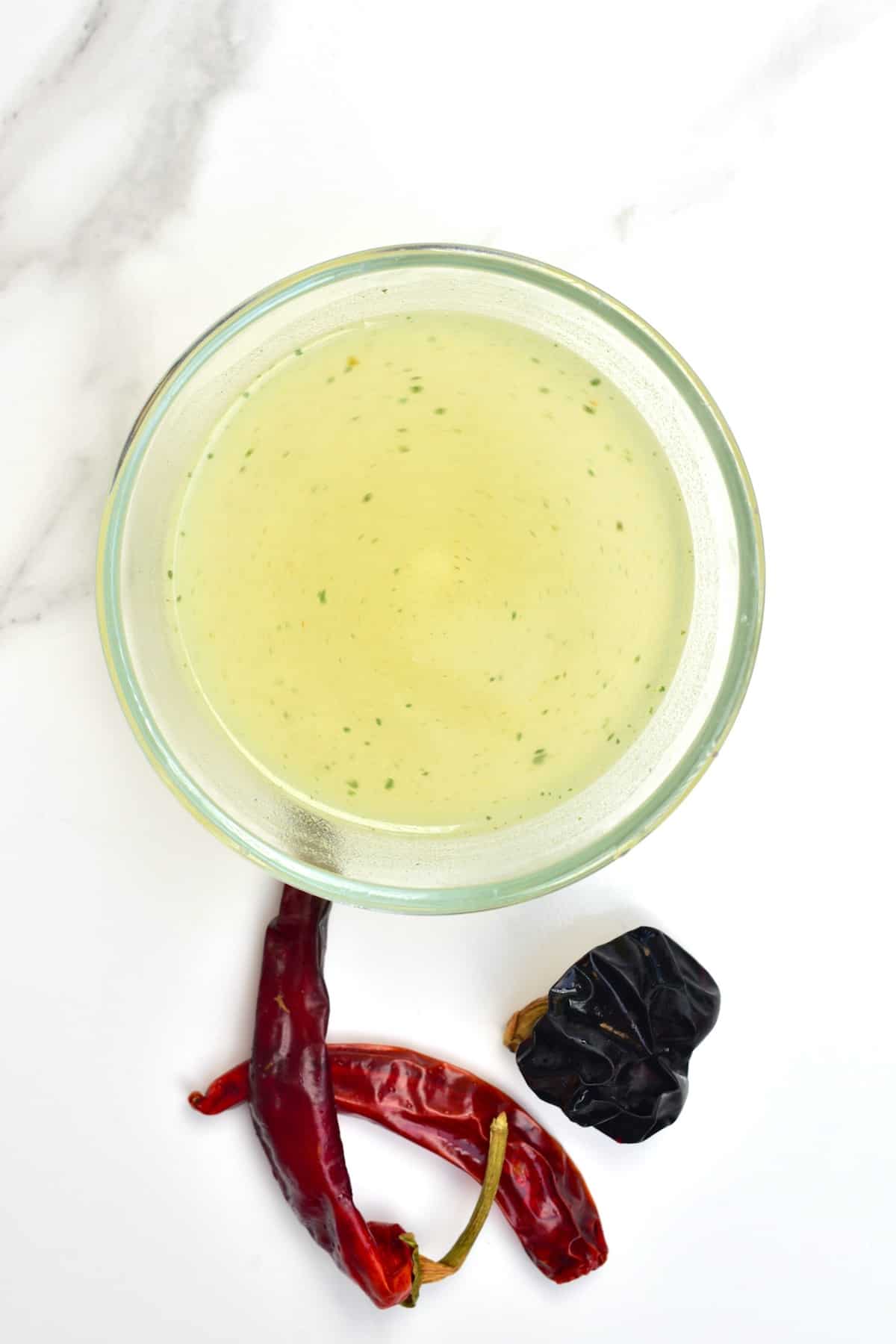
Step 2: Roast the vegetables
There are two methods for doing this. You can ‘prep’ the veg pre-roast or post-roast. To prep them, remove all stems from the tomatoes and chilies and remove the chili seeds (if you want the salsa to be less hot). Also, remove the peel from the onion and garlic.
I tend to do this after roasting – including with the garlic/onion skin, but feel free to remove it first, so you don’t have to do this while they’re hot.
Then roast the ingredients on a parchment-lined tray for 15-20 minutes at 355ºF/180ºC, until soft.
Remove them from the oven and allow them to cool until you can handle them.
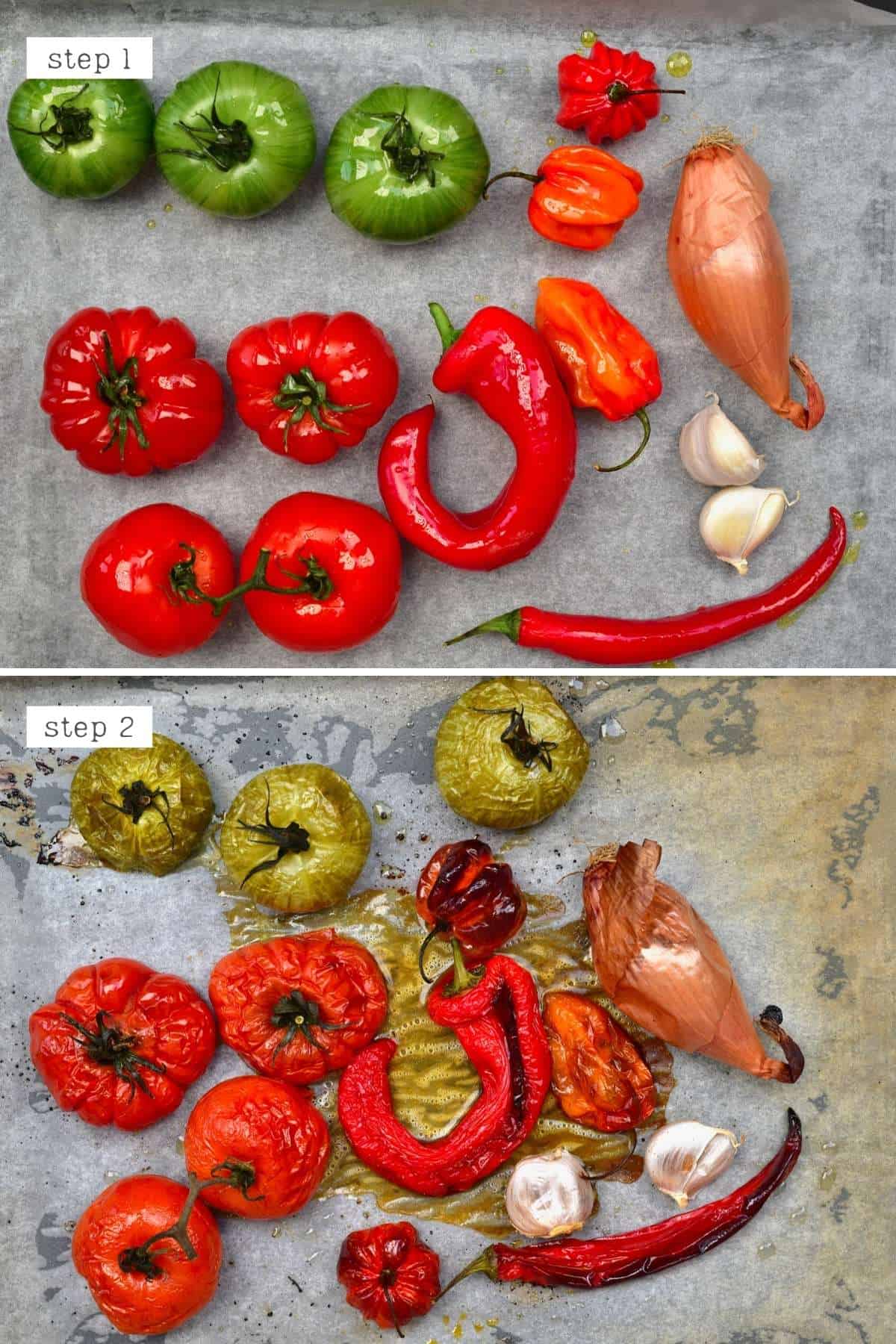
Step 3: Blend the salsa Roja
Add all the roasted vegetables, rehydrated chilies, and the cilantro and lime juice to the blender with a splash of the broth and blend. Adjust the amount of soaking liquid to your liking.
If this is your first time following this recipe, I suggest using chilies at your preferred heat level and adding them bit by bit to the blended, blending well in-between until you find your desired heat level.
Blend the Roja sauce to your preferred texture, then give it a taste. Finally, give it a taste and add a little salt and pepper to taste (sometimes you don’t need any salt at all!)
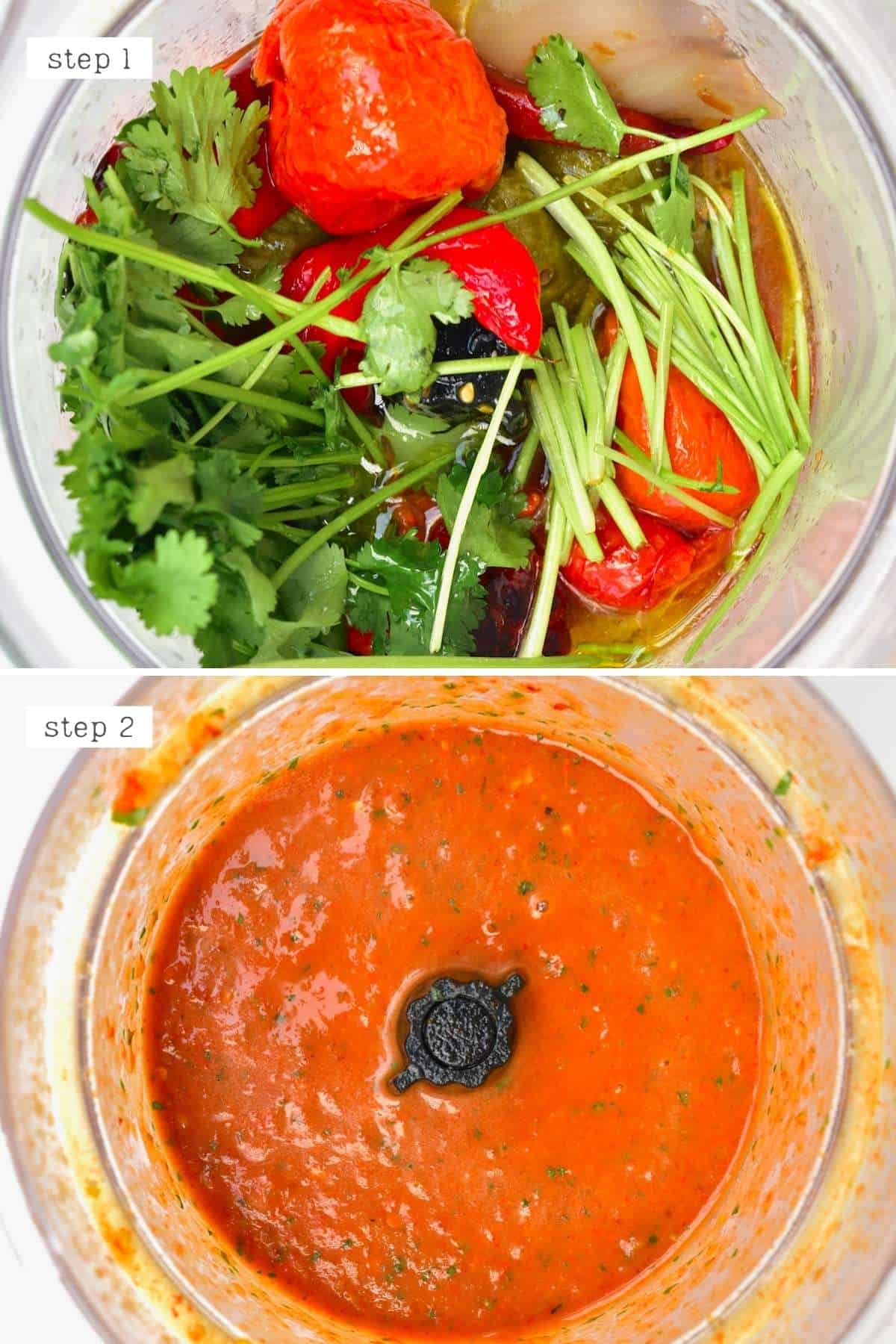
(Optional) At this point, you can enjoy the salsa Roja as is. Alternatively, to further add depth to the salsa, transfer it to a small pot on the stovetop with a spoonful of cooking oil and allow it to simmer and reduce for 15-30 minutes. Add a splash or two more of the soaking liquid if it’s too thick.
How to serve
Once prepared, this salsa Roja is one of the ultimate Mexican condiments. You can use it on top of:
- Ground beef tacos, enchiladas, chilaquiles, tostadas, veggie burritos (or this burrito bowl), meat and fish, etc.
- You can even drizzle it (liberally) over homemade pizza, poached eggs, scrambled eggs or tofu scramble, roasted and pan-fried potatoes, or even oven-baked fries. You can even add a little to the water when cooking rice for delicious Mexican cilantro lime rice!
Think of it as the Mexican ketchup or mayo in your life and use it on everything (like this chili sauce, too)! It’s especially delicious with my shrimp fajitas, which are packed with fresh, vibrant flavors.
How to store
Store: Once prepared, this salsa Roja recipe will last between 7-10 days in an airtight container in the fridge. You can further enhance the shelf life with a splash of extra lime juice or vinegar to increase the acidity.
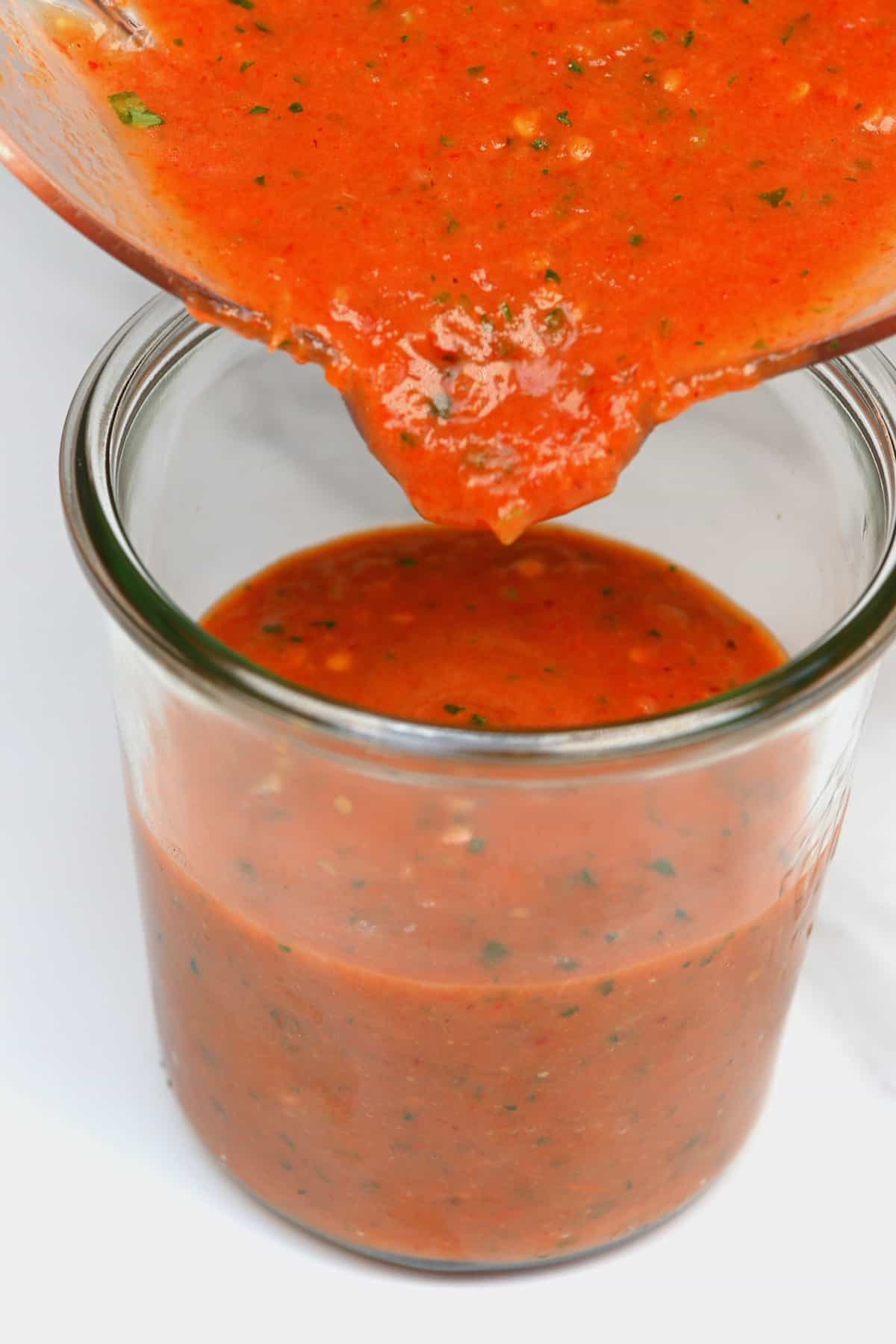
FAQs
Yes. This salsa roja recipe can be allowed to cool completely before transferring to ice-cube trays to portion or freezer-safe bags. Freeze for between 3-4 months.
Allow it to thaw in the fridge or at room temperature before using. If you’ve frozen it in bags you can place them in a bowl of hot water for faster thawing.
Yes, you can. You could also use a food processor or even go machine-free with a molcajete/mortar and pestle. The texture will vary depending on which you use, and going machine-free certainly requires a bit of arm muscle.
Recipe tips
- You can enjoy this as a raw ‘salsa cruda’: Simple omit the roasting step, blend all the ingredients, taste, and adjust. You can optionally simmer it on the stovetop for 15-20 minutes to reduce it slightly and enhance the flavors. Fresh salsa roja will only last 2-3 days in the refrigerator. The cooking step helps to enhance the shelf life by several days.
- Adjust the texture: Based on how much you blend (or process/mash) the ingredients; you can prepare a slightly chunkier vs. smooth salsa Roja.
- Add more citrus or a splash of apple cider vinegar to further enhance the shelf life.
Related recipes
- Tomatillo Green Chili Salsa (Salsa Verde)
- Easy Mango Salsa (Mango Pico De Gallo)
- Chimichurri Sauce (Authentic Chimichurri + Variations)
- Quick & Simple Watermelon Salsa
- Chamoy Sauce
- The Best Vegan Chilli
- How To Make Spiced Corn Ribs (Corn ‘Riblets’)
- Mexican Fire-Roasted Salsa (Roasted Tomato Salsa)
If you try this salsa roja recipe, I’d love to hear your thoughts/questions below. Also, I’d appreciate a recipe card rating below. Feel free to tag me in your recipe recreations on Instagram @Alphafoodie!
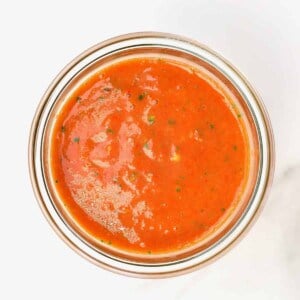
Easy Salsa Roja Recipe (Roja Sauce)
Ingredients
- 1 lime
- 4 medium red tomatoes Roma of Beef Steak work best but any ripe fresh tomato will work.
- 3 medium green tomatoes or tomatillos (more authentic- optional)
- 3 garlic cloves adjust to your preferred level
- 1 onion
- 2 long red chilies check notes*
- 3 Scotch bonnets or less, to taste (check notes*)
- 3 dried chilies or less, to taste (check notes*)
- 2 Tbsp olive oil
- 1 cup vegetable stock heated, or water + salt, or water + vegetable stock powder
- handful cilantro adjust to preferred level
Instructions
Step 1: Rehydrate the dried chilies
- Rehydrate the dried chili peppers. First, cut off the stems and remove the seeds from the peppers. Then add them to a bowl of hot vegetable stock (for better flavor) or lightly salted boiling water. Simply toss them into the liquid and allow them to steep for 20-30 minutes.Alternatively, for more depth of flavor, first, dry roast the peppers in a skillet for just 40-60 seconds per side, then rehydrate them for 15-30 minutes (based on the pepper thickness).Save the liquid as you can use a little to help blend the salsa Roja.
Step 2: Roast the vegetables
- There are two methods for doing this; You can ‘prep’ the veg pre-roast or post. To prep them, remove all stems from the tomatoes and chilies and remove the chili seeds (if you want the salsa to be less hot). Also, remove the peel from the onion and garlic.I tend to do this after roasting – including with the garlic/onion skin, but feel free to remove it first, so you don’t have to do this while they’re hot.
- Then roast the ingredients on a parchment-lined tray for 15-20 minutes at 355ºF/180ºC, until soft.
- Remove them from the oven and allow them to cool until you can handle them.
Step 3: Blend the salsa Roja
- Add all the roasted vegetables, rehydrated chilies, and the cilantro and lime juice to the blender with a splash of the broth and blend. Adjust the amount of soaking liquid to your liking.If this is your first time following this recipe, I suggest using chilies at your preferred heat level and adding them bit by bit to the blended, blending well in-between until you find your desired heat level.
- Blend the Roja sauce to your preferred texture, then give it a taste. Finally, give it a taste and add a little salt and pepper to taste (sometimes you don’t need any salt at all!)(Optional) At this point, you can enjoy the salsa Roja as is. Alternatively, to further add depth to the salsa, transfer it to a small pot on the stovetop with a spoonful of cooking oil and allow it to simmer and reduce for 15-30 minutes. Add a splash or two more of the soaking liquid if it’s too thick.
How to Store
- Once prepared, this salsa Roja recipe will last between 7-10 days in an airtight container in the fridge. You can further enhance the shelf life with a splash of extra lime juice or vinegar to increase the acidity.
Notes
- You can enjoy this as a raw ‘salsa cruda’: Simple omit the roasting step, blend all the ingredients, taste, and adjust. You can optionally simmer it on the stovetop for 15-20 minutes to reduce it slightly and enhance the flavors. Fresh salsa roja will only last 2-3 days in the refrigerator. The cooking step helps to enhance the shelf life by several days.
- Adjust the texture: Based on how much you blend (or process/mash) the ingredients; you can prepare a slightly chunkier vs. smooth salsa Roja.
- Add more citrus or a splash of apple cider vinegar to further enhance the shelf life.
- Chiles: I like to use a combination of fresh and dry red chiles to add tremendous depth to the Roja sauce- For an authentic Mexican salsa, you can use Jalapeno (medium heat and similar to the medium red chilies I used), serrano (slightly hotter), or Arbol chilies (even hotter). For dried chilies, Guajillo is an excellent medium heat option or dried ancho (mild). I also added some very hot West African scotch bonnet peppers to this version as I had them in my pantry, but they’re 100% optional. Read the notes for more on this!
Nutrition
Nutrition information is automatically calculated, so should only be used as an approximation.


